Operational Oceanography
By Naomi Oreskes
During the Cold War, military funding shaped deep-sea research priorities, which resulted in a new understanding of forces below the water’s surface.
During the Cold War, military funding shaped deep-sea research priorities, which resulted in a new understanding of forces below the water’s surface.

Throughout history, naval warfare had mostly been a matter of ships at sea—which is to say ships on the sea—and as such the matters of winds, waves, tides, and currents were of great salience. But these phenomena had been interpreted as essentially surficial; from a naval standpoint, the deep sea was largely irrelevant.
Scientists, in contrast, had long been motivated to understand the deep sea but for the most part lacked the means to do so. This hurdle did not prevent them from trying; nor did it inhibit their theorizing. In the 19th century, there had been a great debate about the origins of currents: whether they were a surface phenomenon related to wind, or a deeper-seated phenomenon perhaps related to variations in temperature and salinity. Some military hydrographers, notably the 19th-century hydrographer Matthew Fontaine Maury, had engaged in these debates, but most naval officers felt they had more pressing things to worry about.
In the mid-20th century, their perspective changed. The effect of World War II on subsurface warfare—and the emerging notion after the war that in the not-too-distant future nuclear-powered submarines would carry nuclear-powered weapons—made the conditions of the deep sea suddenly very pertinent. Indeed, in a future nuclear U.S. Navy, they might become decisive. For the first time in history, scientists and military officers found themselves with a shared interest in the deep sea, particularly the interrelated questions of the origin of (surface) currents and whether there might be deep-ocean circulation.
Deep-ocean interest was reinforced in the 1950s by the emergence of nuclear waste as a political and scientific problem. To many people, the ocean seemed a good place to dump high-level radioactive waste, but this belief rested on the assumption that there were no deep currents, or only very sluggish ones, so that radioactive waste put at the bottom of the sea would remain there. If strong currents swept the seafloor, then the wisdom of disposing of dangerous waste in the deep sea was doubtful at best.
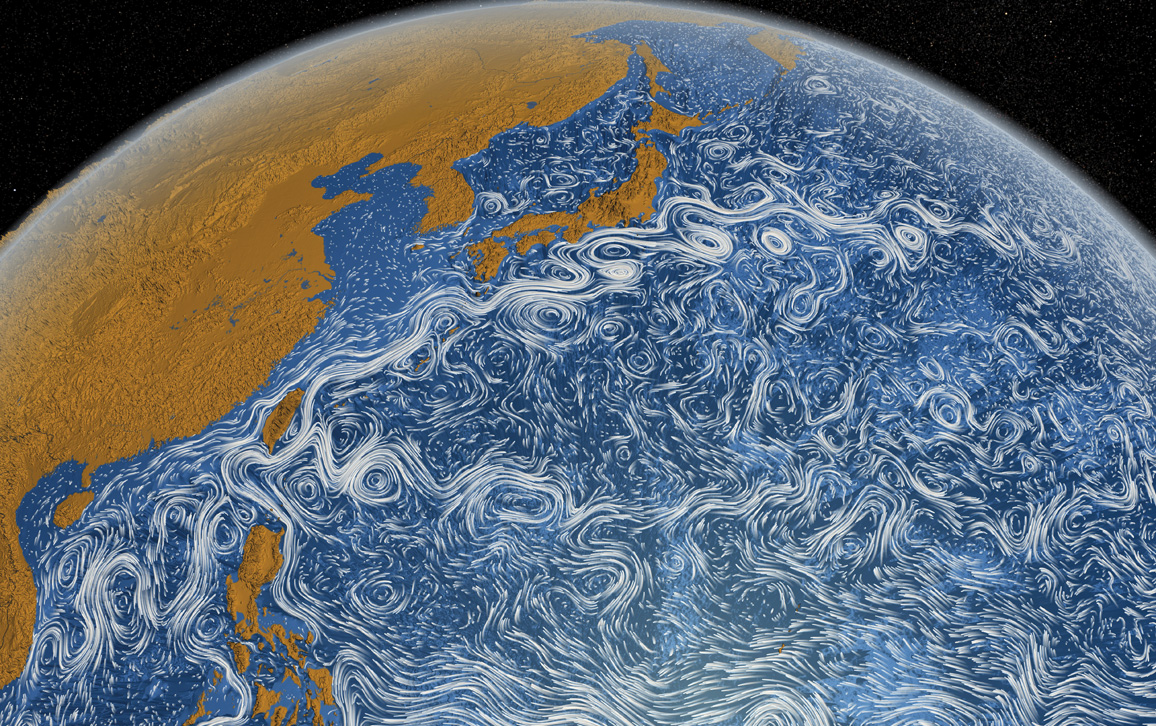
Greg Shirah/Scientific Visualization Studio/NASA
Thus in the 1950s, both the U.S. Navy and the U.S. Atomic Energy Commission invested substantial resources in the study of the deep sea. One result of this confluence of scientific, military, and political interest was a comprehensive research program at Woods Hole Oceanographic Institution in Massachusetts. There, Henry Stommel (1920–1992) and Arnold Arons (1916–2001) constructed the first generally accepted mathematical model of abyssal circulation (deep-ocean current patterns), which demonstrated that there is deep-sea circulation and that density differences are central to it.
The Stommel–Arons model of abyssal circulation still provides key elements of our basic theoretical framework of ocean circulation: density-driven circulation combined with the Earth’s rotation. Cold water sinks in relatively limited areas, but there is an upward flow of water throughout the abyssal ocean. Density-driven circulation combined with the Earth’s rotation also explains the existence of western boundary currents (such as the Gulf Stream, where surface currents hit the North American coast and turn north) and the phenomenon known as “westward intensification”—the strengthening of the western arms of ocean currents. The Stommel–Arons model predicted that these currents—already recognized at the time in some of the world’s oceans—had to be a general phenomenon, an insight often cited by oceanographers as a rare example of a successful prediction in their field.
But this profound scientific breakthrough did not come simply from thinking harder or more clearly. Nor did it come from collecting more or better data. It came from Stommel’s paying attention to a natural phenomenon—the thermocline—that other oceanographers had mostly ignored but whose understanding had proved critical to successful sonar operation.
The immediate postwar years were an anxious time for all American scientists as they wondered whether wartime military largesse would continue, but the anxiety was particularly acute for oceanographers. Few Americans before the war had ever made professional careers in the field. But less than a year after the end of World War II, Woods Hole signed a contract with the Office of Naval Research to continue investigations begun during the war on oceanographic questions relevant to Navy concerns. Officially, the title was “military defense oceanography”; Woods Hole staff called it the “basic task.” Its stated goal was to increase “our knowledge of oceanographic phenomena.” In practice, the contract formalized the relationship forged between Woods Hole and the Navy during the war: one of mutual interest in shared concerns but with a primary focus on aspects of physical oceanography relevant to military operations.
For the following two decades, military defense oceanography would be the basic task of Woods Hole. If oceanographers saw the U.S. Navy as a good patron—and nearly all of them did—the basic task contract illustrates why. The Navy wanted to increase oceanographic knowledge and so did oceanographers. It seemed natural, and even obvious, that the relationship forged in war should be continued in peace to mutual benefit. If Woods Hole would change as a result, those changes would mostly be for the better, as the institution would be able to pursue oceanographic investigations with a vigor and consistency that was previously impossible.
However, the Navy was inevitably more interested in some aspects of oceanography than others; not all oceanography could be characterized as “military defense oceanography.” Three areas received particular attention: dynamic oceanography, surface and internal waves, and abyssal circulation.
By the late 1950s, Stommel was in charge of the Internal Waves and Abyssal Circulation Group at Woods Hole. He had made his name in 1948 with an analysis of western boundary currents, in which he demonstrated that westward intensification was a direct result of the variation of the Coriolis effect (the interaction between pressure gradients and the Earth’s rotation) with latitude. (See the blog post “The Coriolis and the Commode,” June 15, 2015.)
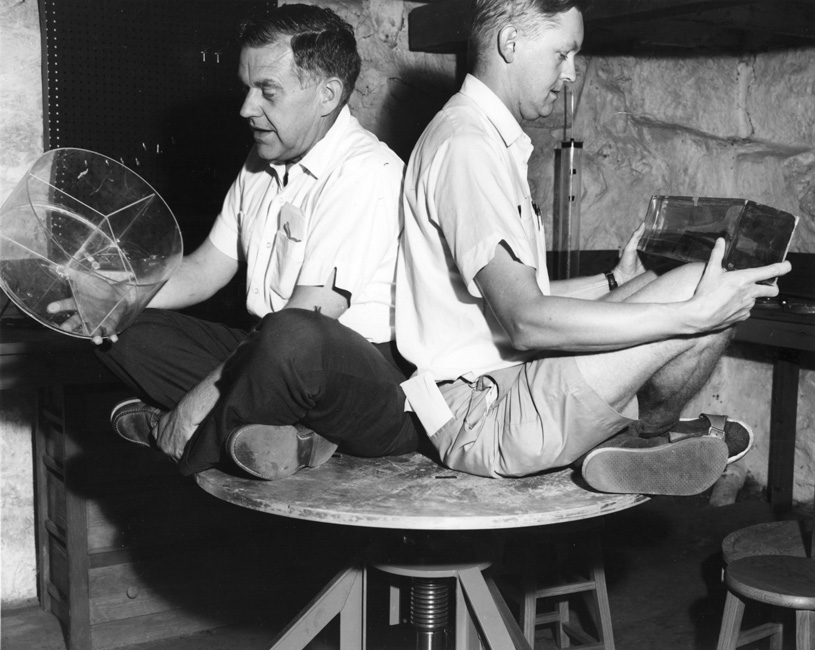
Photo courtesy of Woods Hole Oceanographic Institution Archives
Stommel lived with myriad tensions and contradictions. He expressed misgivings over the application of science to warfare, yet his fame was based on work funded almost entirely by the U.S. Navy. Philosophically, he was committed to personal autonomy and viewed scientific research as an expression of individual curiosity and creativity, yet he became a driving force behind several highly political, big-science projects of the 1970s. He accepted that large-scale data-gathering enterprises were necessary—indeed, he believed that all previous oceanographic advances had been rooted in new and better data—yet he worried that large enterprises were risky to individual autonomy and creativity.
In October 1957, Stommel reviewed the state of knowledge of abyssal circulation in the pages of Nature. Stommel attributed the impasse on the issue of deep-ocean circulation to insufficient empirical evidence. Everyone accepted that there was wind-driven horizontal displacement of water masses, tied to Earth’s rotation. But was there also a significant vertical component? That question was unresolved. Rather than perpetuate the impasse, Stommel took a novel approach. He said, in effect, “Let us assume that there is.” We can do this by conceptualizing the ocean as being composed of two layers, across which there is vertical transport. If we do, we find that the rest of the ocean circulation falls out surprisingly simply. Forget for a moment about the winds. Forget about the descending cold polar waters in the North Atlantic and in the Southern Ocean’s Weddell Sea. Imagine instead a general upward vertical diffusion throughout the abyssal ocean: If one presumes that there is such vertical transport, then one can calculate the currents required to accommodate it.
It would not be unreasonable to say that the analysis of the thermocline and its effects on sound transmission was the most important wartime development in oceanographic science.
When most oceanographers thought about vertical transport, they imagined it downward—the sinking of dense water in a few unusually cold areas. Stommel was turning this idea upside down and imagining a general upward diffusion throughout the abyss. He illustrated this process in a series of sketches showing flow controlled only by vertical transport, flow controlled only by horizontal transport, and flow controlled by a combination of both. The latter, he argued, was closest to the empirical evidence, which suggested that it was unhelpful to think of the ocean as having two different forms of circulation—wind driven and density driven. It was more useful simply to envisage circulation, in which the horizontal effects were in part dependent on the vertical transport, and vice versa. Crucially, if one specified the horizontal transport, the rest of the picture would be “determined.” Put another way, “arbitrary assumptions about the vertical velocity structure in the ocean are attended by the most far-reaching implications concerning the form of the horizontal current pattern.”
Stommel disavowed any aspiration to have his conceptual model interpreted as a theory: “These considerations, and the pictures derivable from them, are not theories,” he insisted. “They merely provide an interpretive tool, and indicate what flow patterns must be associated with various distributions of vertical transport across level surfaces.” Stommel no doubt wished to deflect potential criticism that his model was mathematically underdeveloped, and over the following 10 years he worked with colleagues to dignify his model sufficiently to call it a theory. More than that, he worked to show that it was true.
Stommel’s first step in transforming his speculative concept into a persuasive and accepted scientific theory was to test it experimentally. In an article published in Tellus in 1958 and coauthored by Arons and Woods Hole colleague Alan Faller, Stommel pursued his concept with a simple experimental setup, designed to simulate what he saw as the key element of ocean circulation: fluids on a rotating sphere. They theorized that if the ocean is a dynamic system in which fluids are moving, those movements can be analyzed in terms of sources of water (where water flows into a region) and sinks (where water flows away).
The use of the term sink in this context can be confusing; in everyday life, a sink is something in which water drains down. Stommel is not using the term in that way. Rather, in this discussion a source is anything that brings fluid into any area under consideration, and a sink is anything that removes it. (This concept is comparable to contemporary discussions of sources and sinks of carbon dioxide in the atmosphere.)
In this theory, westward-flowing currents are a source of ocean water into the western sides of basins, and eastward-flowing currents are a sink. The same reasoning applies in the vertical dimension. In the Weddell Sea, cold polar waters move down into the abyssal ocean, creating a source of cold, deep water. Upward vertical diffusion is a source of cold water into the upper reaches of the seas. Thus, wind is either a source or sink, depending on which way the wind drives fluids, and the same is true for density differences. Moreover, these driving agents may operate in the vertical or the horizontal dimension.
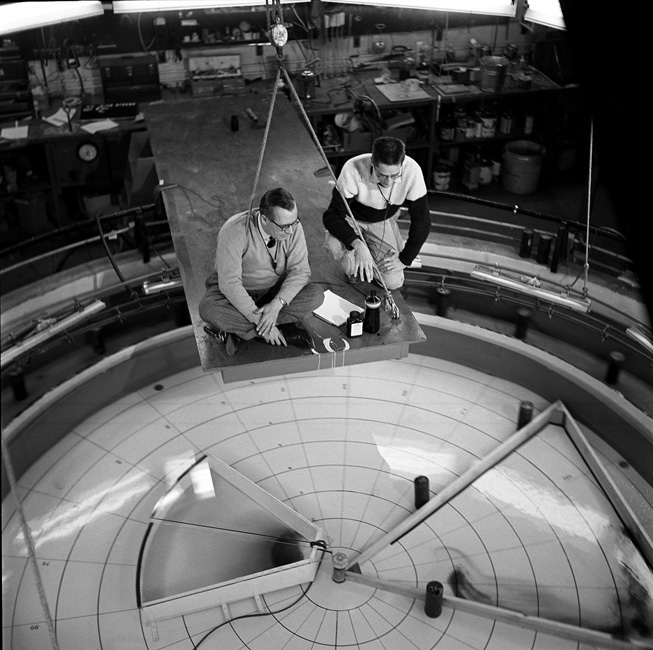
Photo by Jan Hahn / © Woods Hole Oceanographic Institution
To test their thought experiment, Stommel, Arons, and Faller set up a physical experiment, using a design proposed by their Woods Hole colleague, William von Arx (see photograph above). They began with a 2.1-meter-diameter rotating tank. To simulate the effect of a radially shaped ocean basin, they used wooden partitions to isolate a pie-shaped sector, with a width of 60 degrees. The tank contained a set of quarter-inch slots at various positions in the walls and was covered so as to prevent wind stress on the surface and simulate only the effects of sources and sinks—which is to say, only the effects of density-driven circulation. Mass could be added through the slots from a large can of dyed water connected to the main tank by a tube; a small can of additional water was connected to the large can to maintain the hydraulic pressure.
With this setup, they mimicked the conditions in each of three idealized cases. First, they created a source and sink at an arbitrary point at the eastern side of the basin. Then they created a source at the pole with a sink in the basin center; then a source at the southwest corner with a sink at the pole; and then a source at the southwest corner with a sink in the basin center. The results were as predicted: In every case, the basin exhibited a western boundary current with return flow, and in the latter two cases, toward the source. Conceptualization, mathematical analysis, and physical experiments aligned.
In some sense, these experiments merely confirmed what was already accepted about surface circulation, but the territory Stommel had staked was not the surface but the abyss. He therefore had to return to the question of vertical transport, and for this purpose he revisited the first topic in oceanography he had confronted when he joined Woods Hole in 1944: the thermocline. Its existence was a perplexing aspect of ocean dynamics and critical to the operation of submarines.
In previous studies, dynamic oceanographers had analyzed the ocean by drawing heavily on analogies to the atmosphere, but there was one crucial difference: The atmosphere is warmed from below, which fosters convection, but the ocean is warmed from above, which hinders it. Convection can therefore drive circulation in the atmosphere and foster mixing in a manner that in the ocean it cannot. But there is a significant complication. If the ocean were entirely thermodynamically stable, and therefore entirely unmixed, the temperature would drop gradually with depth. But that is not the case. In the ocean, the upper 50 to 200 meters are generally warm (typically between 5 degrees Celsius and 30 degrees Celsius), and the deep ocean is close to freezing. Between them is a zone of rapid temperature drop known as the thermocline.
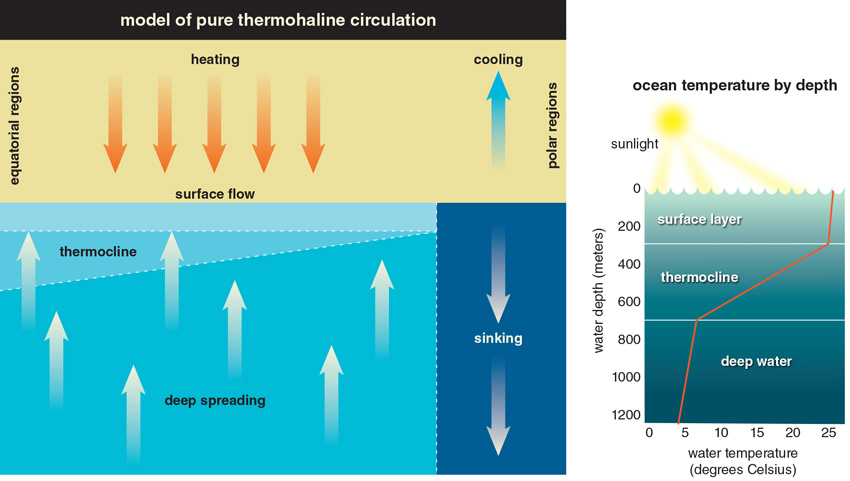
Barbara Aulicino, Stacey Lutkoski
The thermocline had been sedulously studied during World War II because of its importance to antisubmarine warfare, which lay in the crucial fact that the velocity of sound is density dependent. As temperature drops rapidly through the thermocline, the density of water increases and sound waves are refracted, just as light is refracted as it travels through media of different density. From a military perspective, this fact was of surpassing significance, because refraction of sound waves through the thermocline produces acoustic shadow zones where submarines may rest undetected. Moreover, whereas temperature falls with depth, salinity generally increases (because surface layers are diluted by rainfall); these countervailing effects produce a zone of minimum velocity—the sound channel—in which sound waves can be very effectively transmitted.
The sound channel proved effective in determining the position of a submerged submarine or an airman downed at sea (the airman could release a small explosive and the sound waves would be detected, even at great distance) and became the basis of a new military navigational system—Sound Fixing and Ranging, or SOFAR. After the war, this technology became the basis of the Sound Surveillance System, or SOSUS, the system of underwater cables and hydrophones used to detect and track Soviet submarines throughout the Cold War. It would not be unreasonable to say that, from an operational standpoint, the analysis of the thermocline and its effects on sound transmission was the most important wartime development in oceanographic science.
Woods Hole had been a center for temperature and salinity studies on behalf of antisubmarine warfare, and the detailed study of the thermocline was a major focus of military-scientific interest in oceanography. By the end of World War II, the thermocline was one of the most well documented of all ocean features. It is perhaps not surprising, then, that Stommel focused attention on the thermocline. What is surprising is that so few others did.
Stommel called the thermocline “one of the mysteries of the sea,” because it was not at all obvious why there should be one. Why wasn’t the transition between surface and deeper layers gradual? Why was the water immediately below the thermocline so cold, even in the tropics? Stommel insisted that the thermocline had to account for the presence of cold water nearly everywhere. As he pointed out,
The really deep water, between 4,000 feet and the bottom at 18,000 feet, is close to freezing, even in the tropics. This must mean that most of the water in the oceans flows [toward the middle and low latitudes] from regions near the poles. However, there are no strong currents in the deeper regions of the ocean. The great wind-driven currents are confined to the upper quarter of its depth.
The presence of cold water throughout the ocean meant that water must be being moved from the poles to the rest of the abyssal ocean, but how? Clearly something was missing from the prevailing thinking.
Stommel recognized that the deep currents were too weak to measure with a current meter, and in any case, there was no way to get instruments to the required depths. The answer would have to be theorized. In a characteristic pattern, Stommel at first outlined a qualitative solution and then developed it quantitatively. In his 1957 report in Nature, Stommel had already answered the question. The key assumption—laid out in this early sketch—was vertical transport. But it was not just any form of vertical transport; it was upward vertical transport throughout the ocean. Stommel’s analysis began by inviting the reader to presume upward vertical flow throughout the abyss.
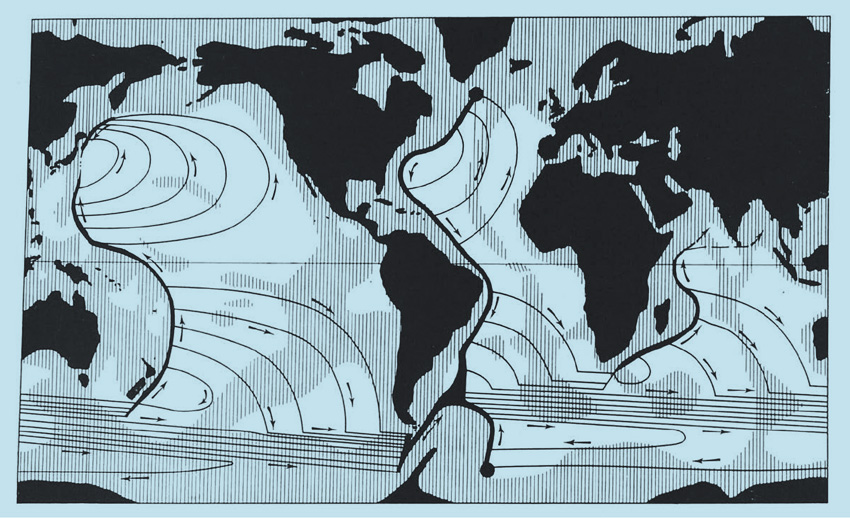
Courtesy of Elsevier, © Elsevier 1959, DOI: 10.1016/S0146-6291(58)80014-4
Instead of asking, as others had done, why deep water is so cold, Stommel asked how the surface layer stays warm. His answer was “upward flow which prevents the hot water at the surface from gradually working down into the deep water.” In short, the fact of the thermocline meant that there had to be upward flow to maintain it. Here was the explanation simultaneously for the characteristics of both the deep ocean and the thermocline: the upwelling of water throughout the abyssal ocean. Upward diffusion both mixed the abyssal ocean and prevented surface waters from mixing; this activity created and sustained the observed thermal structure. The Stommel–Arons model hung on the existence of the thermocline. Put another way, it hung on attending to the thermocline where others had not.
The presence of cold water throughout the ocean meant that water must be being moved from the poles to the rest of the abyssal ocean, but how?
Stommel developed these ideas mathematically in an article coauthored with Woods Hole colleague Allan Robinson, published in Tellus in 1959. The parameters of their mathematical model followed their physical one: a bounded basin driven by a meridional temperature gradient at the surface on a rotating sphere, represented mathematically by a Coriolis parameter varying with latitude. Solving the relevant equations, Stommel and Robinson were able to show that a deep circulation could be generated by the observed meridional differences in surface temperatures, from equator to poles, and that there must be an upward vertical component of flow to maintain the thermocline. The upward flow was the sink that permitted the downward advection of dense waters elsewhere. The sink consisted of water moving upward, which permitted the polar regions to be a source of cold water to the abyssal sea.
Abyssal circulation was not analogous to a conveyor belt, on which coherent water parcels sank at the poles, maintained their identity, and rose at the equator. Rather, parcels lost their identities—like the dye of Stommel’s experiments—as the water within them diffused throughout the entire abyssal ocean. That there were only two small sources of cold water (the North Atlantic and the Weddell Sea) and the entire abyssal ocean was the sink might have seemed a bold—even crazy—claim. But the thermocline was the proof, because without the abyssal sink there would be no thermocline.
The Stommel–Arons model was laid out in a five-part paper published over the course of 12 years. The most critical were the first two parts, published in Deep Sea Research in 1960. Stommel and Arons provided the mathematical treatment for the concept developed in the rotating tank experiments: a system driven by sources and sinks except at the western boundary, where an intense current develops. The source could be any driving force—including displacement of water masses by wind—but their focus was the sink, defined as the upward transfer of fluids throughout the abyssal ocean.
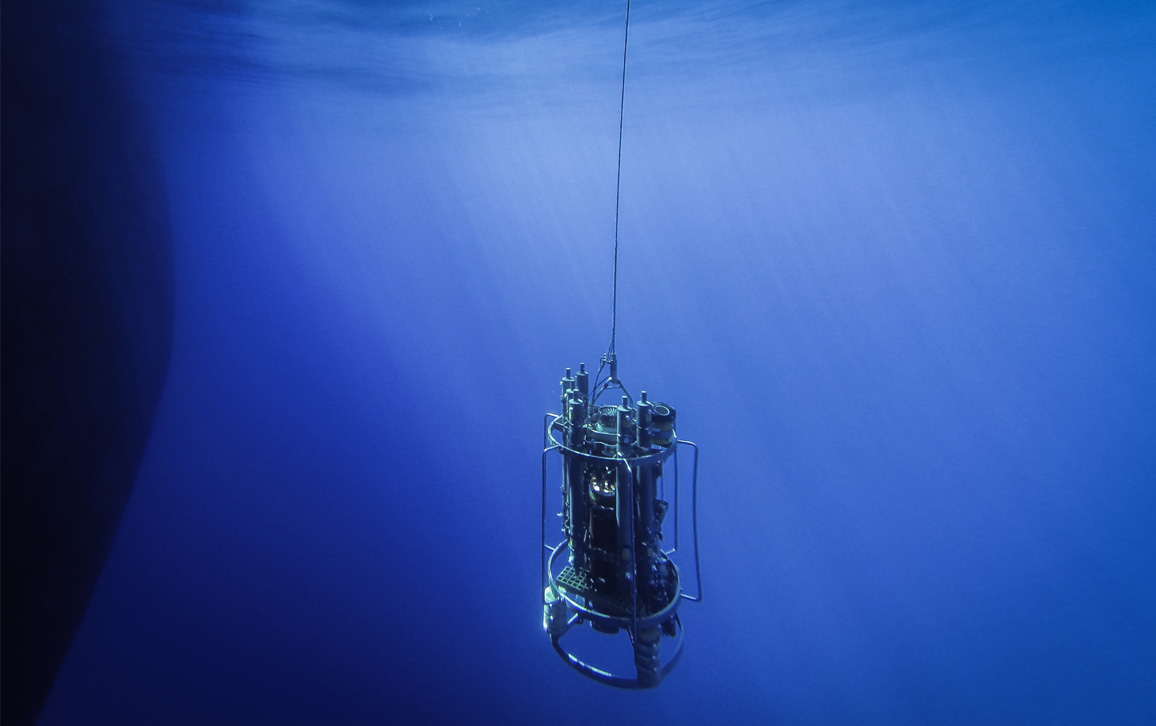
Photo by Sean P. Whelan/ © Woods Hole Oceanographic Institution
The model hung on two key points. One, as already noted, was the existence of the thermocline, which justified the assumption of a distributed sink across the whole ocean. The other was the evidence provided by oceanographer Georg Wüst and others for two sources of cold water: the North Atlantic and the Weddell Sea. Connecting the sources and sinks provided the conceptual picture that they developed mathematically: a treatment that confirmed the requirement for intense western boundary currents and predicted that these currents would develop no matter where the source of the water was. Indeed, one of the most important results of the model is that it does not much matter where the source lies. Whether the source is at the equator or the pole, a western boundary current is required to satisfy the requirements of the Coriolis effect and conservation of mass.
In the second paper, Stommel and Arons pursued the question of the residence time of deep waters, a question that greatly concerned the Atomic Energy Commission. They showed that the residence time of deep waters was likely to range between 200 and 1,800 years—consistent with the diverse conclusions of their colleagues, but not very reassuring if one were hoping to dump radioactive waste in the deep sea.
With these papers, the tour de force had been transformed into a quantitative scientific theory. Attending to the thermocline had led Stommel and Arons to a new and convincing theory of the ocean and, with it, to the resolution of a question that had vexed scientists for centuries. But there is at least one more important contribution that should rightly be viewed as part of this story—not least because of its importance to Stommel’s lasting influence in oceanography today: his analysis of whether ocean circulation could display different stable regimes and his conclusion that it could.
In a paper in Tellus in 1961—which today has more than 1,000 citations—Stommel argued that a thermohaline convective system (circulation driven by changes in temperature, density, and salinity) could exhibit two different stable regimes: one in which temperature differences dominated and one in which salinity differences dominated. In the ocean, temperature and salinity differences work against each other—because warm waters tend to be saltier—and warm surface water overlying cold, deep water presents a stable situation that can be altered only if the surface waters become very cold or very salty. For this reason, contemporary oceanographers had been skeptical about thermohaline effects. Because heat transfer tends to be faster and more efficient than the processes that change salinity—mainly evaporation, but also mixing, diffusion, and the creation of sea ice—in the natural world, as currently constituted, temperature effects dominate. Thus, it had been reasonably assumed that warm waters would tend to stay near the surface and cold waters to remain at depth. Ergo, no thermohaline circulation.
Our modern understanding of deep-ocean circulation was made possible not just by military funding but also by the ways in which operational concerns forced attention to the thermocline.
But one could imagine a different situation in which salinity differences predominated. In a series of thought experiments, Stommel imagined adjacent basins with different temperature and salinity conditions and solved the equations representing heat and salinity transfer between them. In the case where two vessels were connected by a capillary tube at the bottom (through which deep, dense water could move) and an overflow connector at the top (through which shallow, less dense water could move), there were two stable solutions to the equations: one in which temperature effects dominated, and one in which salinity effects dominated, which suggested that two different stable regimes could exist in nature.
These possibilities are of heightened concern today, as we move into a climatic regime that has not existed on Earth for at least 100,000 years. As Stommel wrote,
The fact that even in a very simple convective system . . . two distinct stable regimes can occur . . . suggests that a similar situation may exist somewhere in nature. One wonders whether other quite different states of flow are permissible in the ocean or some estuaries and if such a system might jump into one of these with a sufficient perturbation. If so, the system is inherently fraught with possibilities for speculation about climatic change.
Stommel’s recognition of the potential implications of two different stable regimes is part of his lasting legacy. Nearly all oceanographers know that. But what most scientists don’t know is that his research is also part of the lasting legacy of Cold War military defense oceanography. Our modern understanding of deep-ocean circulation was made possible not just by military funding but also by the ways in which operational concerns forced attention to the thermocline. The military didn’t simply foot the bill for Stommel’s work; military concerns forced scientific attention. Military defense oceanography created a context that led Stommel to pay attention to an aspect of the ocean that just about everyone else had ignored.
The Stommel–Arons model proved powerful not only because it answered a long-standing question in oceanography but also because it made specific, testable predictions about the natural world that turned out to be true. Today, scientists continue to debate the details of thermohaline circulation, particularly its effect on climate. The effect of thermohaline circulation on the strength and location of the Gulf Stream has become a major point of concern—even fear—in discussions of the potential effects of global warming. It has inspired dystopic anxieties and a bad Hollywood film. But while scientists continue to argue about the details, no one disputes that there is thermohaline circulation, and for that we largely have Henry Stommel to credit.
This article is excerpted and adapted with permission from Science on a Mission: How Military Funding Shaped What We Do and Don’t Know about the Ocean by Naomi Oreskes, published by the University of Chicago Press. ©2021 by the University of Chicago. All rights reserved.
Click "American Scientist" to access home page
American Scientist Comments and Discussion
To discuss our articles or comment on them, please share them and tag American Scientist on social media platforms. Here are links to our profiles on Twitter, Facebook, and LinkedIn.
If we re-share your post, we will moderate comments/discussion following our comments policy.